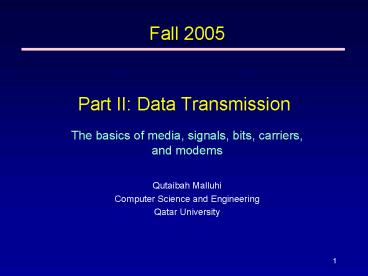Part II: Data Transmission - PowerPoint PPT Presentation
1 / 19
Title:
Part II: Data Transmission
Description:
Overview of transmission media used in network systems. 3. Sending Data ... Data transmitted using radio waves. Conceptually similar to radio, TV, pagers ... – PowerPoint PPT presentation
Number of Views:46
Avg rating:3.0/5.0
Title: Part II: Data Transmission
1
Part II Data Transmission
Fall 2005
- The basics of media, signals, bits, carriers, and
modems
Qutaibah Malluhi Computer Science and
Engineering Qatar University
2
Fall 2005Transmission Media
- Overview of transmission media used in network
systems
3
Sending Data
- At sender encode data as energy and transmit
energy - At receiver decode energy at destination back
into data - Energy can be electrical, light, radio, sound,
etc. - Each form of energy has different properties and
requirements for transmission - Transmitted energy is carried through some sort
of medium copper, glass, air, ...
Medium
Sender (encodes data)
Receiver (decodes data)
data 10110 110
data 10110 110
4
Physical Layer and Data Transmission
5
Copper Wire
- Primary medium to connect computers
- Inexpensive
- easy to install
- low resistance to electric current gt signal
travels further - Interference How to minimize?
- Twisted pair
- Coaxial cable (Coax)
- Shielded twisted pair
6
Twisted Pair
- One wire for signal and other as ground reference
- Receiver uses the difference between signal
- Receiver is immune to interference if both wires
are affected equally - Twisting
- limits electromagnetic energy these wires emit
- protects the wires from external interference
- Two wires has same distance to noise source. One
is closer in one twist, the other is closer in
the second twist.
7
UTP and STP
- Unshielded Twisted Pair (UTP)
- Classified into 7 categories based on cable
quality - Category 1 is the lowest quality (phone) and 5 is
the most common today (100 Mbps Ethernet) - Shielded Twisted Pair (STP)
8
Coaxial Cable
- Can carry higher frequencies that TP
- Improved performance through shield
- Particularly useful for wires that pass next to
equipment generating EM fields
9
Glass Fibers
- Thin glass fiber carries light with encoded data
- Plastic jacket allows fiber to bend (some!)
without breaking - Fiber is very clear and designed to reflect light
internally for efficient transmission - Light emitting diode (LED) injects light into
fiber. Light sensitive receiver at other end
translates light back into data - Applications
- Backbone networks (cost-effective wide-bandwidth)
- Backbone of TV cable networks (coax for
connection to premise) - Some LANS (100baseFX and 1000base-X Ethernets)
10
Glass Fibers More Details
11
Glass Fiber Adv. and Disadv.
- Advantages
- Much higher bandwidth
- Signal generation and not the medium is the
bottleneck today - No electromagnetic interference
- Further signal distances (less signal
attenuation) - 50 KM for fiber vs. 5 KM for copper
- Better encoding of bits (store more bits in
signal) - More immune to tapping
- Disadvantages
- Special installation equipment
- difficulty of joining fibers
- Unidirectional (but requires single wire no
ground) - difficulty to locate fiber problems
12
Connectors
Twisted Pair Connectors
Coax Connectors
Coax Connectors
13
Radio
- Data transmitted using radio waves. Conceptually
similar to radio, TV, pagers - Energy travels through the air rather than copper
or glass - Physical connection is not required
- Antennas are needed
- Omni-directional (travels in all directions)
- Can travel through walls and through an entire
building - Can be long distance or short distance
- Long distance with satellite relay
- Short distance wireless computer network
14
Wireless Network
- Wireless bridge and net interface
15
Microwave
- High frequency radio waves
- 2-300 GHz
- Higher speed than lower frequency RF signals
- Unidirectional, for point-to-point communication
- Can not penetrate structures clear path is
required - Line of sight transmission
- Antennas mounted on towers relay transmitted data
16
Infrared
- Infrared light transmits data through the air
- Similar to technology used in TV remote control
- Can propagate throughout a room (bouncing off
surfaces), but will not penetrate walls - Becoming common in personal digital assistants
17
Laser
- Unidirectional, like microwave
- Higher speed than microwave
- Uses laser transmitter and photo-sensitive
receiver at each end Point-to-point, typically
between buildings - Can be adversely affected by weather
18
Satellites
19
Summary
- Copper wire is mature technology, rugged and
inexpensive maximum transmission speed is
limited - Glass fiber
- Higher speed
- More resistant to electro-magnetic interference
- Spans longer distances
- Requires only single fiber
- More expensive less rugged
- Radio and microwave don't require physical
connection - Radio and infrared can be used for mobile
connections - Laser also does not need physical connection and
supports higher speeds































